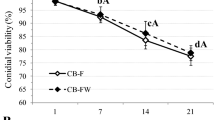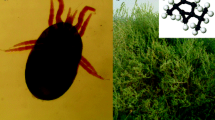Abstract
Resistance to conventional synthetic pesticides has been widely reported in Dermanyssus gallinae in different aviary systems. Cardboard traps containing acaricides had been introduced as a successive device for collection and control of the poultry red mite. The present study assessed field efficacy of traps containing carvacrol in the control and reduction of D. gallinae in laying poultry farm. Two different carvacrol-based formulations were tested for their toxicity and possible repellent activity on D. gallinae to determine the most appropriate formulation and concentration to be used in the field study. In vitro tests confirmed that 1 % carvacrol formulation with ethoxylated castor oil as emulsifier was significantly toxic to D. gallinae without any dissuading effect in comparison to ethanol and higher concentrations of carvacrol (p < 0.05). A subsequent in vivo experiment in a cage system laying farm demonstrated significant acaricidal activity for traps containing 1 % carvacrol. Throughout the study, untreated cardboard traps were used for monitoring mite populations. Carvacrol-impregnated traps were efficacious in the control of D. gallinae and led to over 92 % reduction in mite’s population after 2 week of application. Toxic effects of carvacrol maintained through 2 weeks after the last application of traps. Results of the present study suggested that effective control of the poultry red mite can be achieved by traps containing carvacrol. These traps can be used safely in poultry facilities without any concern about residues in eggs, meat, and environment.




Similar content being viewed by others
References
Abdel-Ghaffar F, Sobhy HM, Al-Quraishy S, Semmler M (2008) Field study on the efficacy of an extract of neem seed (Mite-Stop®) against the red mite Dermanyssus gallinae naturally infecting poultry in Egypt. Parasitol Res 103(3):481–485
Abdel-Ghaffar F, Semmler M, Al-Rasheid K, Mehlhorn H (2009) In vitro efficacy of ByeMite® and Mite-Stop® on developmental stages of the red chicken mite Dermanyssus gallinae. Parasitol Res 105(5):1469–1471
Ahn YJ, Lee SB, Lee HS, Kim GH (1998) Insecticidal and acaricidal activity of carvacrol and β-thujaplicine derived from Thujopsis dolabrata var. hondai Sawdust. J Chem Ecol 24:81–90
Chauve C (1998) The poultry red mite Dermanyssus gallinae (De Geer, 1778): current situation and future prospects for control. Vet Parasitol 79:39–45
Chikuba T, Itou H, Sakakibara H, Inoue D (2008) Detection of fowl pox virus from red mite (Dermanyssus gallinae) at a layer farm occurring cutaneous fowlpox. J Jpn Soc Poult Dis 44:113–117
Chirico J, Tauson R (2002) Traps containing acaricides for the control of Dermanyssus gallinae. Vet Parasitol 110:109–116
Chirico J, Eriksson H, Fossum O, Jansson D (2003) The poultry red mite, Dermanyssus gallinae, a potential vector of Erysipelothrix rhusiopathiae causing erysipelas in hens. Med Vet Entomol 17:232–234
Faghihzadeh Gorji S, Faghihzadeh Gorji S, Rajabloo M (2014) The field efficacy of garlic extract against Dermanyssus gallinae in layer farms of Babol, Iran. Parasitol Res 113:1209–1213
Fiddes MD, Le Gresley S, Parsons DG, Epe C, Coles GC, Stafford KA (2005) Prevalence of the poultry red mite (Dermanyssus gallinae) in England. Vet Rec 157:233–235
George DR, Smith TJ, Shiel RS, Sparagano OAE, Guy JH (2009) Mode of action and variability in efficacy of plant essential oils showing toxicity against the poultry mred mite, Dermanyssus gallinae. Vet Parasitol 161:276–282
Govindarajan M, Rajeswary M, Arivoli S, Tennyson S, Benelli G (2016a) Larvicidal and repellent potential of Zingiber nimmonii (J. Graham) Dalzell (Zingiberaceae) essential oil: an eco-friendly tool against malaria, dengue, and lymphatic filariasis mosquito vectors? Parasit Res 1–10
Govindarajan M, Rajeswary M, Hoti SL, Bhattacharyya A, Benelli G (2016a) Eugenol, α-pinene and β-caryophyllene from Plectranthus barbatus essential oil as eco-friendly larvicides against malaria, dengue and Japanese encephalitis mosquito vectors. Parasitol Res 115(2):807–815
Hamidi A, Sherifi K, Muji S, Behluli B, Latifi F, Robaj A, Postoli R, Hess C, Hess M, Sparagano OAE (2011) Dermanyssus gallinae in layer farms in Kosovo: a high risk for Salmonella prevalence. Parasit Vectors 4:136
Jayakumar S, Madankumar A, Asokkumar S, Raghunandhakumar S, Gokula Dhas K, Kamaraj S, Divya MG, Devaki T (2012) Potential preventive effect of carvacrol against diethylnitrosamine-induced hepatocellular carcinoma in rats. Mol Cell Biochem 360:51–60
Kilpinen O, Roepstorff A, Permin A, Norgaard-Nielsen G, Lawson LG, Simonsen HB (2005) Influence of Dermanyssus gallinae and Ascaridia galli infections on behaviour and health of laying hens (Gallus gallus domesticus). Br Poult Sci 46:26–34
Kim S, Yi J, Tak J, Ahn Y (2004) Acaricidal activity of plant essential oils against Dermanyssus gallinae (Acari: Dermanyssidae). Vet Parasitol 120:297–304
Kim S, Na YE, Yi JH, Kim BS, Ahn YJ (2007) Contact and fumigant toxicity of oriental medicinal plant extracts against Dermanyssus gallinae (Acari: Dermanyssidae). Vet Parasitol 145:377–382
Kirkwood AC (1968) Anemia in poultry infested with red mite Dermanyssus gallinae. Vet Rec 80:514–516
Kočišová A, Plach’y J (2008) Novel approach to controlling the poultry red mite (Acarina: Mesostigmata). In: Proc. Int. Conf. Urban Pests, 6th, Budapest. OOK-Press Kft, Hungary, pp. 349–54
Locher N, Al-Rasheid KA, Abdel-Ghaffar F, Mehlhorn H (2010) In vitro and field studies on the contact and fumigant toxicity of a neem-product (Mite-Stop®) against the developmental stages of the poultry red mite Dermanyssus gallinae. Parasitol Res 107(2):417–423
Lundh J, Wiktelius D, Chirico J (2005) Azadirachtin-impregnated traps for the control of Dermanyssus gallinae. Vet Parasitol 130(3):337–342
Mehlhorn H (2016) Available means to control bloodsucking ticks, mites and insects—an overview. In: Nanoparticles in the fight against parasites. Springer International Publishing, pp. 37–45.
Nordenfors H, Höglund J (2000) Long term dynamics of Dermanyssus gallinae in relation to mite control measures in aviary systems for layers. Br Poult Sci 41:533–540
Nordenfors H, Chirico J (2001) Evaluation of a sampling trap for Dermanyssus gallinae (Acari: Dermanyssidae). J Econ Entomol 94(6):1617–1621
Rahbari S, Nabian S, Ronaghi H (2009) Haematophagus mites in poultry farms of Iran. Iran J Arthropod Borne Dis 3:18–21
Schmahl G, Al-Rasheid KA, Abdel-Ghaffar F, Klimpel S, Mehlhorn H (2010) The efficacy of neem seed extracts (Tre-san®, MiteStop®) on a broad spectrum of pests and parasites. Parasitol Res 107(2):261–269
Semmler M, Abdel-Ghaffar F, Al-Rasheid K, Mehlhorn H (2009) Nature helps: from research to products against blood-sucking arthropods. Parasitol Res 105(6):1483–1487
Sparagano O, Pavlicevic A, Murano T, Camarda A, Sahibi H, Kilpinen O, Mul M, van Emous R, le Bouquin S, Hoel K, Cafiero MA (2009) Prevalence and key figures for the poultry red mite Dermanyssus gallinae infections in poultry farm systems. Exp Appl Acarol 48:3–10
Tabari MA, Youssefi MR, Barimani A, Araghi A (2015) Carvacrol as a potent natural acaricide against Dermanyssus gallinae. Parasitol Res 114(10):3801–3806
Wang FF, Wang M, Xu FR, Liang DM, Pan BL (2010) Survey of prevalence and control of ectoparasites in caged poultry in China. Vet Rec 167:934–937
Author information
Authors and Affiliations
Corresponding author
Rights and permissions
About this article
Cite this article
Barimani, A., Youssefi, M.R. & Tabari, M.A. Traps containing carvacrol, a biological approach for the control of Dermanyssus gallinae . Parasitol Res 115, 3493–3498 (2016). https://doi.org/10.1007/s00436-016-5113-3
Received:
Accepted:
Published:
Issue Date:
DOI: https://doi.org/10.1007/s00436-016-5113-3




